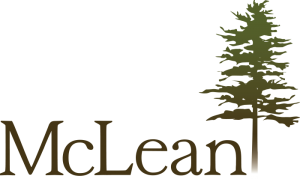Most of us have heard that stretching is beneficial, but we may have questions about different methods of stretching and how frequently to stretch. What are the current concepts in muscle-stretching methods? Physical Therapist Jenny Braddock, Director of Rehabilitation at McLean, gives us a closer look at stretching.
“Human movement is dependent on many factors, one of which is the amount of range of motion available in a joint,” notes Jenny. Range of motion may be limited by joints or soft tissue, which includes muscles, ligaments, tendons, and nerves. One common reason for reduced range of motion is muscle tightness caused by an increase in tension, as in the case of muscle length shortening through scarring or postural adaptations.
In general, the aim of stretching is to increase the length of muscles, tendons, and fascia. Two techniques of stretching are commonly known as static stretching and dynamic stretching.
Static stretching refers to holding a specific position with the muscle on tension for a period of time. This can be performed actively through self-stretching, or passively, such as with help from another individual. Dynamic stretching involves controlled movement or activity repeated several times through ranges of motion. In both cases, effective stretching can improve joint range of motion, which in turn may improve function as well as reduce injury.
Both static and dynamic stretching improve flexibility and range of motion, but the literature is conflicting as to which type of stretching is most effective for different purposes. “People have unique responses to various types of stretching, therefore it is important stretching programs are designed to meet the needs and goals of the individual,” says Jenny.
In general, static stretching is most beneficial for individuals following activity with the goal of increasing joint range of motion and reducing injury by maintaining muscle length. Dynamic stretching may be more beneficial for individuals prior to activity or competition. The American College of Sports Medicine recommends stretching be performed at least 2-3 days per week and each stretch repeated 2-4 times, holding the position for 30 seconds following active warm-up. Stretching should be performed to the point of feeling tightness and generally pain should be avoided.
To learn more about stretching techniques and the best methods for your needs, consider reaching out to physical or occupational therapists for guidance. McLean offers outpatient therapy on our campus in Simsbury – call 860-658-3745 to see if our therapists can help you stretch your way to better health.
(Resource: International Journal of Sports Physical Therapy. 2012 Feb; 7(1): 109-119)

